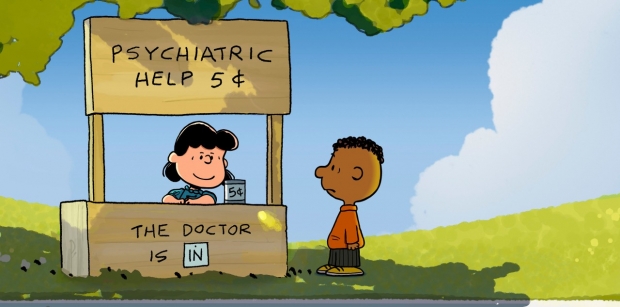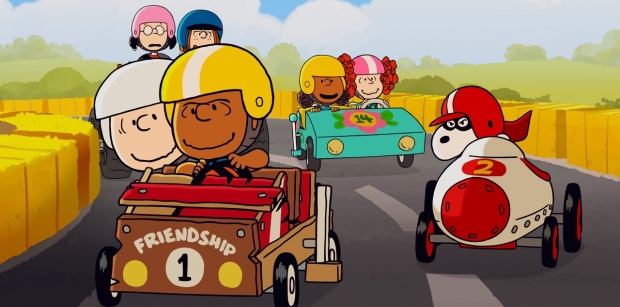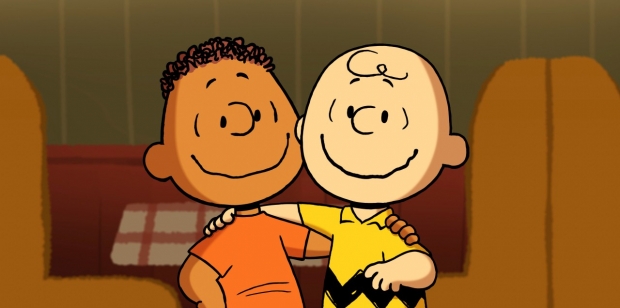Executive producer Craig Schulz, director Raymond S. Persi, and co-writer Robb Armstrong discuss the latest ‘Snoopy Presents’ special in the storied franchise, which tells the backstory of one of the most beloved members of the “gang;” the show debuts February 16 on Apple TV+.
Premiering today, February 16, on Apple TV+, the all-new Peanuts TV special, Snoopy Presents: Welcome Home, Franklin, provides yet another shining example of how the iconic franchise, launched as a comic strip by Charles M. Schulz back in 1950, continues to grow, entertaining new audiences while holding in a gentle, loving hug everything fans have always loved about the “gang” for over 70 years.
It was almost 60 years ago, in July 1968, that the first Black “Peanuts” character, Franklin, debuted in print. And now he finally gets to share his backstory. In the new special, Franklin and his family are always moving as his dad is in the military. Everywhere Franklin goes, he finds support in a notebook filled with his grandfather’s advice on friendship. But when he tries his usual strategies with the Peanuts gang, he has trouble fitting in. That’s until he learns about the neighborhood Soap Box Derby race - and according to his grandfather, everyone loves a winner! He’s sure that winning the race will also mean winning over some new friends. All he needs is a partner, which he finds in Charlie Brown. The two work together to build a car and, in the process, become good buddies. But as the race nears, the pressure mounts - can their car and their newfound friendship make it to the finish line?
Produced for Apple TV+ by Peanuts and WildBrain, the special is directed by Emmy Award winner Raymond S. Persi (The Simpsons, Wreck-It-Ralph) and co-written by Robb Armstrong (Jump Start) along with Craig Schulz, Bryan Schulz, and Cornelius Uliano, from an original story by Armstrong and Scott Montgomery (The Snoopy Show). Executive producers are Craig Schulz, Bryan Schulz, Uliano, Paige Braddock, Josh Scherba, Stephanie Betts, and Logan McPherson.
Enjoy the trailer and a set of three clips before learning more about how the show was produced:
“The Franklin special shows the tremendous evolution of what we started with in the Snoopy Presents series on Apple TV+, really exploring the Peanut's universe, taking it character by character,” says Craig, Charles’ son and shepherd of all things “Peanuts.” “The fans always want to know more and more about the characters, and you can only grab so much from reading the comic strip. You can hypothesize, you can think what they're like, but to actually see them come to life, see the emotions on their faces as they communicate with each other, and the way that Raymond and the animation team brings that to the screen, that is really, really special.”
“When we’re doing these specials, we try to parallel what my dad did in the comic strip,” he adds. “We write for adults and make it entertaining for children. To do that, you have to have numerous elements to make it come across, so it’s entertaining. Whether it’s the animation, design, music, voices, or story, they have all got to come together; otherwise, people get bored, and they'll switch to a different channel.”
Joining Craig’s team for the project was Armstrong, known for the long-running comic strip “JumpStart” currently in development as a TV series at CBS. “So, I, Brian, and Neil [Cornelius Uliano] got together… three white guys trying to write a story on Franklin,” Craig shares. “It posed a dilemma for us. And that's when we reached out to Robb Armstrong and said, ‘Hey, can you come on board and lend us the piece of the puzzle that we don't have? We have a lot of it, but we're missing pieces, and we need you to fill it in.’ And Robb jumped in with both feet and became co-writer.”
“I came into this a lot like Franklin's coming into this, which made it easier,” Armstrong says. “I don't want to use the word easy, because all of it was challenging, but relating so closely to Franklin's plight helped. I understand him. It's weird because I do a comic strip myself. I've been doing ‘JumpStart’ for 34 years, but I'm not like the characters in ‘JumpStart.’ I'm not like any of them. But it's different with Franklin. I'm a lot like him. I'm coming into this established world of the Schulz projects, the established world of a group of TV guys who've written other screenplays and stuff. And it's not unlike what he's walking into.”
In the special, as he arrives in town, surveying a group of white kids as he drives by in a station wagon, Franklin says to himself, “Sure is a lack of variety in this place.” It’s a subtle, nuanced, yet powerful statement, said so matter-of-factly. Asked about the scene, Craig replies, “I'm glad you touched upon that. This poor kid has lived out of a suitcase his whole life. He's never had a home; never had kids he could bond with. And probably the strangest place he could end up in would be in Charlie Brown's universe with a kid in the pumpkin patch and the girl in the psychiatrist booth and the crazy dog running around pretending he's fighting the Red Baron.”
He continues, “Kids connect at a different level than adults do. When adults meet, they put on a persona of what they've accomplished, whether it be their job, their awards, or their car. Kids don’t do that. They don't come into a room and as soon as they meet say, ‘Hey, I won the spelling bee last week, and I got this toy car…’ They bond on a different level. And I think that's what Franklin does when he meets these other kids. They connect on the simplest level. What's your favorite music? Do you like baseball? Do you like go-karts? And we built upon that.”
Armstrong adds, “There's a scene in there where Franklin presents a baseball card and says, ‘This is my Great uncle. He was a star in the Negro Leagues.’ And Charlie Brown says, ‘What’s the Negro Leagues?’ Franklin says, ‘There was a time when Black players and white players couldn't play together, and things have changed.’ Franklin's real wise; his grandfather's influence has made him a wise little kid. So, he doesn't indict Charlie Brown for not knowing about the Negro Leagues. He doesn't indict him for what caused that segregation. He just says what is. That's it. And Charlie Brown says, ‘A kid could learn a lot from hanging around a guy like you.’ And that's what this life is all about, man. We could learn a lot from each other. It is tragic when we refuse to. It's tragic when we write people off. It's a casualty of humanity when we say, I don't want to listen to that.”
This is the fourth Snoopy Presents special that Persi has directed; all told, this is the 51st special of the franchise. Once again, the animation perfectly captures the Peanuts look we’re so used to seeing, born in print, and refined over the years as it was adapted to 2D (with a 3D feature in 2015 and one more on the way) with increasingly nuanced, purposeful, and richly designed animation. This time around, courtesy of WildBrain, we’re also treated to some great action sequences of the Soapbox Derby race that pairs Charlie Brown and Franklin together… for better or worse. “The soapbox derby race is amazing,” Persi says. “The animation team did an incredible job with that. We used rig-based and hand-drawn 2D animation, but some of that stuff looks so good I thought they were building 3DCG cars. But they didn't. My animation supervisor, Justin Smith, would tell me about limitations I had to stick to, like we can only have a certain number of angles of cars. So, I'd rework shots to make sure things could work that way. But then he'd always give me more every time. He likes to dampen our expectations, then overdeliver.”
But for Persi, the heart of the show lies in how it depicts the characters’ emotions. Asked how difficult it is to show that emotion using what are essentially simple character designs, he explains, “I love looking at the script and seeing where those pivotal, emotional moments are going to be and making them really shine. As Robb can attest, you can do a lot just with composition and a head tilt. These characters have really simple faces, but spacing the eyes in just the right way conveys that they're feeling something different. That's just part of the fun of the challenge. I love having to work with those minimalist features.”
Craig adds, “And I think the one thing we impressed upon Raymond, that he has really embraced, is to let some of these scenes breathe. Take the time to feel the emotion and really embrace that moment. Very few shows do that at all anymore. They're just rapid pace, cut, cut, cut.”
For several generations now, the world of “Peanuts” has represented a gentle, fun, thoughtful, and safe space for kids and families to spend time in. And Craig is determined to make sure each new franchise effort holds true to the incredible world his father built. “We see this generation after generation after generation,” he says. “People find that ‘Peanuts’ is the safe space to go to. The messaging is solid. The messaging is true. And as the kids watch, afterward they can have conversations with their parents. ‘I really relate to that Black kid, that Franklin kid, he's coming in and it's like when I started at that new school, I didn't know anybody.’ Every kid can relate to the characters on a different level. And I think that is why it's so timeless. There are very few things that are timeless and very few things that are safe.”
Dan Sarto is Publisher and Editor-in-Chief of Animation World Network.

















